1
LoggingThe early settlers in the Tatamagouche and surrounding area depended on farming and the land's natural resources to establish their colony. Lumbering was an early industrial success; Canadian squared pine timber was popular on the English markets, where it was sold by the ton. The wood selection also included black birch, maple, oak, and yellow pine.
The "meeting of the waters", where the French and Waughs Rivers met in Tatamagouche enabled timber to be sent downstream in the earlier days of the industry. This made the shipping and use of timber more possible; a prosperous shipbuilding industry soon evolved. There were many sites for sawmills and many yards for shipbuilding, plenty of labour, seemingly endless supplies of timber and a ready market for wood and ships. This combination of factors repeated in Wallace and River John.
2
2) LUMBERING - Small Scale Operation, North Shore, Nova Scotia, CanadaCirca 1920
North Shore, Nova Scotia, Canada
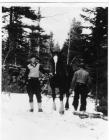 Credits:
Credits:North Shore Archives, CSHC
3
Typical clothing for winter work in the woods appears to have been hard-wearing wool britches, with knee high socks and larrigans-a form of leather moccasin.Winter saw the men working their woodlots, leaving the women to run the farm; the men either returned at night or stayed out in crude shacks. Food was brought out by a family member during the day. Cut lumber was hauled out by hand or by oxen, but with the gradual arrival of horses to the area in the 1820's to 30s, horses and sleds was used, making it easier to move logs across the snow and ice.
Until 1900 Nova Scotia loggers used a single-bitted or American poll axe, and the broad axe. The poll axe replaced the English straight-handled felling axe, and gradually a curved handle developed. Machine made handles did not become available until 1853, and they were sold separately from the axes. In Nova Scotia the handles were made of white ash (not hickory), which was lighter and springy.
A heavy poll axe was used for felling and a lighter weight one for lopping limbs from trees. Most axemen carried a whetstone to keep the axe razor sharp; whetstones were available at Balfron, just outside Tatamagouche.
4
Winter Conditions, North Shore, Nova Scotia, CanadaLate 1800's
North Shore, Nova Scotia, Canada
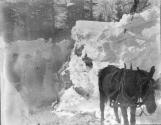 Credits:
Credits:North Shore Archives CSHC
5
Often the snow had to be removed from the log pile before loading it to the sled. Here the snow is higher than the ghostly figures of the men standing in the background. Feeding horses in such conditions was difficult, as they depended on the hay crop, and when that was unavailable it could be expensive if grain was needed. This horse looks a little thin and work weary. Oxen were commonly used until the 1900's. They could work better on rough ground and were less expensive to feed. If one died or was killed, it could be eaten!Winter conditions were harsh; roads were often little better than tracks and were few and far between. For the farmer with only one horse, it involved hours of cold, back-breaking work.
6
Winter Transport, North Shore, Nova Scotia, Canada1900
North Shore, Nova Scotia, Canada
 Credits:
Credits:North Shore Archives CSHC
7
Cleared of snow, logs could be moved by sleds and runners to small scale sawmills. Neighbours often got together to share the workload and equipment. Sometimes the logs may have been taken to a collecting point to be transported to a sawmill elsewhere. With the later development of portable steam engines that could be dragged into the woods to power the saws, logs would be piled up and sawn on site. The stacks of sawn timber would then be transported more efficiently by a number of horse drawn wagons or sleds.8
Winter Logging, North Shore, Nova Scotia, Canada1918-20
North Shore, Nova Scotia, Canada
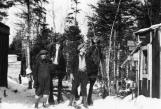 Credits:
Credits:North Shore Archives, CSHC
9
A small shack in the woods enabled some 'independent' hardier woodsmen to spend a night or two away from the farm. Two horses and a good sled meant that often more timber could be hauled out, but it was still hard, slow work. In some instances the father took his sons and stayed out all winter; they might get home for Christmas but in the earlier days they survived in wood huts, the chinks filled with moss; the roof of poles and bark; small doorways and no windows reduced the flow of cold air. They slept on piles of fir boughs on an earth floor. The fireplace in the centre was of stones, and the short chimney of logs was smeared with clay to prevent fires.Cooking was over the open fire. Cooking stoves did not arrive in much of Nova Scotia until the 1840's but when they did reach the lumber camps the cook was able to provide better food.
10
Relaxing in the Woods, North Shore, Nova Scotia, CanadaEarly 1900's
North Shore, Nova Scotia, Canada
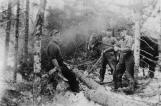 Credits:
Credits:North Shore Archives CSHC
11
In small scale operations, woodsmen used a cross-cut saw and possibly a 'side dog'. The metal spike was struck into the log at one end and then yanked to drag the log out of the brush. It could then be 'snigged' or 'yarded' through the woods by a horse.In the days of square timber, which was required for export, the work crew usually consisted of a liner, a scorer and a hewer.The liner removed the bark on two sides of the log, and drew a line using charcoal or chalk. The scorer stood on the log and scored notches into the wood at regular intervals along the line, each notch reaching the same depth, almost to the proposed finished face of the squared timber. The hewer followed and removed the outer wood, leaving the squared timber face exposed. It was skilled work.
High standards were required and the Nova Scotia legislature in 1814 passed an Act requiring export timber to be straight lined, well squared, square butted at each end, square edged, and free from score marks, rot, worm holes or splits. No spruce or pine was to be shorter than 16 feet (4.8 m) and no hardwood under 10 feet (3m). No square ton timber was considered unless it was squared at least 10 inches (25 cms).
12
William Swan Cookhouse, East Wentworth/West New Annan, Nova Scotia, CanadaEarly 1900's
Wentworth, Nova Scotia, Canada
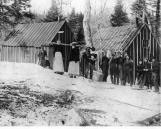 Credits:
Credits:North Shore Archives CSHC
13
As lumbering became more professional, logging sessions often meant long separations from the wife and family. Occasional visits from a wife and child, as shown here, were always welcome. The cook appreciates some female company; father holds his daughter and the crew enjoy a break from work.Food was generally plentiful, with moose, caribou, salt beef, pork and fish, sourdough biscuits, pancakes and molasses. Larger camps later acquired raisins, prunes and dried apples. After 1850, baked beans appeared at every meal. Tea was the usual drink. Some cooks demanded silence at meal times, and in the cookhouse the cook's word was law. Each man had his regular place; he cleared his place, emptied the waste into a container, stacked his dishes and left the cookhouse.
A box of supplies might arrive with the visitors;
Tar paper covered buildings were typical of a logging camp. Dormitory sleeping arrangements were usual, with several men to a room. Until the late 1800's many privies had a pole floor and a seat made from a 5 inch (13 cm) pole. There were three walls and a roof, giving some shelter from the winter weather but no one lingered! By 1890 some camps had privies with four walls, including a door.
Stables or hovels for the livestock, and the privy were downstream of the well. Where possible the stable was near a meadow for hay.
14
Logs Waiting Processing, North Shore, Nova Scotia, Canada1900
North Shore, Nova Scotia, Canada
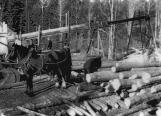 Credits:
Credits:North Shore Archives CSHC